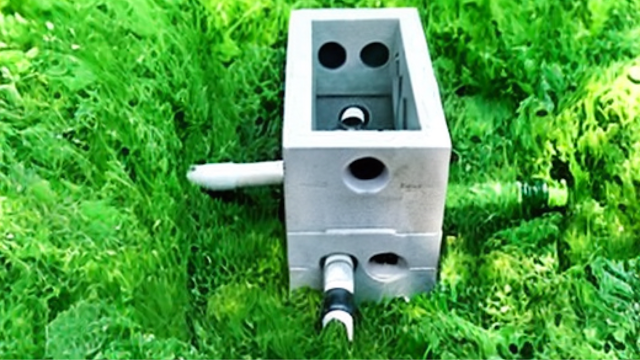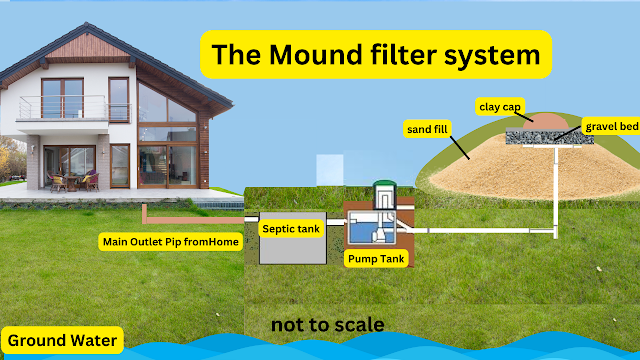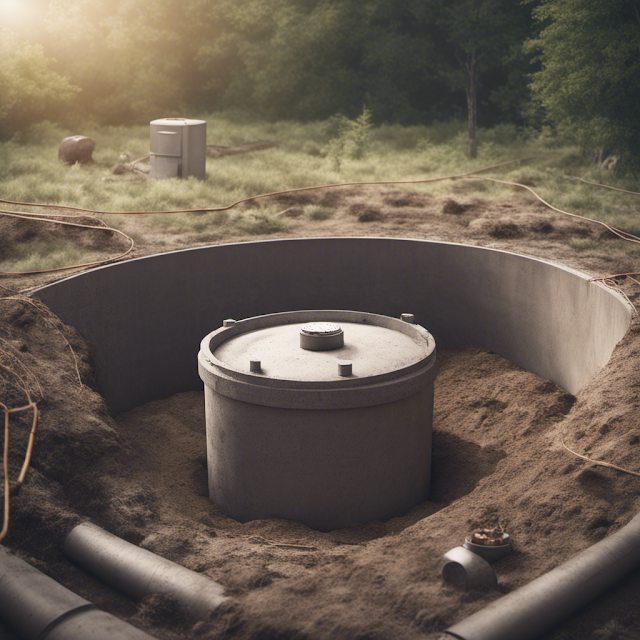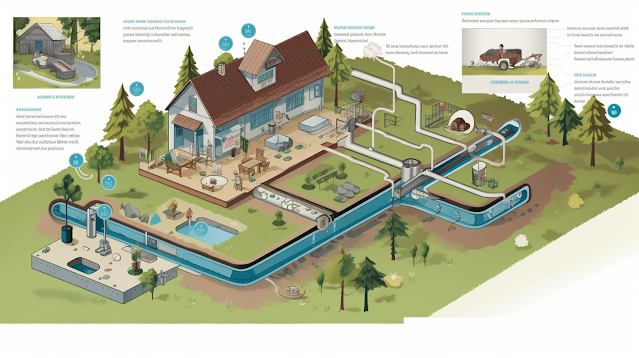Septic Tank Bacteria: The Unsung Heroes of Your Wastewater Treatment System
 |
| protozoa microorganism |
Introduction to Septic Tank Bacteria
If you are a homeowner with a septic tank then, you probably already know that it requires regular maintenance to keep it functioning properly or you should know. One of the most important components of a septic tank system is the bacteria that lives inside it.
These tiny little microorganisms play a crucial role in breaking down the waste that enters the tank ensuring that your system operates efficiently. In this article, we will discuss the importance of septic tank bacteria and the types of bacteria found in septic tanks, and how we need to be able to maintain a healthy bacterial population for your septic system to work efficiently.
As owners my wife Jeane and I Michael of a Septic Tank Company for over 40 years we experienced most situations for septic tanks good and bad. The purpose now in our later years is to pass on our knowledge and guidance to others. Bacteria by the way is one of my favorite subjects when it comes to septic tanks!
1. What are septic tank bacteria?
Septic tank bacteria are microorganisms that live inside a septic tank and help to break down organic waste matter that enters the tank.
These bacteria are classified as anaerobic, meaning that they do not require oxygen to survive. Instead, they obtain the energy they need by breaking down organic matter through a process called anaerobic digestion.
Factors Affecting Septic Tank Bacteria Population
Septic systems are an essential part of many households, particularly in rural areas where public sewer systems are not available.
One of the key components of septic systems is the bacteria that live in the septic tank, breaking down solid waste and treating the wastewater.
In this article, we will discuss the factors that affect the population and health of these bacteria, including pH levels, temperature, oxygen levels, presence of toxic substances, and nutrient availability.
Importance of Bacteria in Septic Tanks
Bacteria plays such a crucial role in the functioning of septic systems. These microorganisms are responsible for breaking down organic waste, such as human excreta, food particles, and paper products, into much simpler compounds to dispose of.
This process helps in the reduction of the volume of solids in the tank and aids in the overall treatment of wastewater before it's discharged into the drain field.
Maintaining a healthy bacteria population in the septic tank is essential to ensure the efficient and effective operation of the system.
Factors Affecting Bacteria Population
pH Levels
Ideal pH Range
Bacteria in septic tanks thrive in a specific pH range, typically between 6.8 and 7.2. This slightly acidic environment allows for the optimal growth and metabolic activity of the bacteria, ensuring efficient breakdown of waste materials.
Effects of Imbalanced pH Levels
If the pH levels in the septic tank become too acidic (below 6.8) or too alkaline (above 7.2), the bacteria population may suffer. Imbalanced pH levels can inhibit bacterial growth and metabolic activity, leading to a reduction in the efficiency of waste breakdown and potentially causing system malfunctions.
Temperature
Ideal Temperature Range
The optimal temperature range for septic tank bacteria is between 60°F and 100°F (15°C to 38°C). This range allows for the most efficient bacterial activity, promoting rapid waste decomposition and effective wastewater treatment.
Effects of Temperature Fluctuations
Extreme temperature fluctuations, either too hot or too cold, can negatively affect the bacteria population in the septic tank. High temperatures can lead to excessive bacterial activity, causing rapid depletion of oxygen and nutrient resources. On the other hand, low temperatures can slow down bacterial activity, leading to incomplete waste breakdown and reduced treatment efficiency.
Oxygen Levels
Aerobic vs. Anaerobic Bacteria
Septic tanks contain both aerobic (oxygen-loving) and anaerobic (oxygen-hating) bacteria. Aerobic bacteria are generally more efficient
at breaking down waste, but they require oxygen to survive. Anaerobic bacteria, on the other hand, can function without oxygen and are primarily responsible for breaking down more complex waste materials.
Effects of Low Oxygen Levels
Low oxygen levels in the septic tank can negatively impact the aerobic bacteria population, reducing their ability to break down waste efficiently. This can lead to a buildup of solids in the tank and potential system issues. Ensuring proper aeration and maintaining a balanced mix of aerobic and anaerobic bacteria are essential for optimal septic system performance.
Presence of Toxic Substances
Common Toxic Substances
Various household chemicals and substances can be toxic to septic tank bacteria, including bleach, disinfectants, paint thinners, solvents, and some medications. These substances can enter the septic system through drains and toilets and have the potential to harm the bacteria population.
Effects of Toxic Substances on Bacteria
Exposure to toxic substances can lead to a reduction in bacterial populations or even complete elimination of certain bacterial species. This can significantly reduce the efficiency of waste breakdown and compromise the overall performance of the septic system. It's essential to be cautious when disposing of potentially harmful chemicals and substances to protect the bacteria in your septic tank.
Nutrient Availability
Essential Nutrients for Bacteria
Bacteria in septic tanks require specific nutrients to support their growth and metabolic activities. These nutrients include carbon, nitrogen, and phosphorus, which are typically present in the organic waste that enters the septic tank.
Effects of Nutrient Imbalance
A nutrient imbalance in the septic tank, either due to a deficiency or excess of essential nutrients, can negatively impact the bacteria population. An imbalance can hinder bacterial growth and activity, leading to a decrease in the efficiency of waste decomposition and potential system issues. Regular maintenance and monitoring of your septic system can help identify and address any nutrient imbalances to ensure the health and productivity of the bacteria population.
2. The role of bacteria in a septic tank system
The bacteria in a septic tank system play a vital role in the treatment of wastewater. When organic waste enters the tank, the bacteria break it down into simpler compounds such as carbon dioxide, water, and methane gas. These byproducts are then released into the soil through the drain field, where they are further broken down and filtered by natural processes. Without the presence of these bacteria, the waste in the septic tank would accumulate and lead to system failure.
3. Types of bacteria found in septic tanks
There are two main types of bacteria found in septic tanks: aerobic and anaerobic bacteria. Aerobic bacteria require oxygen to survive and are responsible for breaking down organic matter in the presence of air. Anaerobic bacteria, on the other hand, do not require oxygen and are responsible for breaking down organic matter in an oxygen-deprived environment, such as a septic tank.
4. How to maintain a healthy bacterial population in your septic system
Maintaining a healthy bacterial population in your septic system is crucial for its proper functioning. Here are some tips to help you do that:
4.1 Avoid harsh chemicals and cleaners
Harsh chemicals and cleaners can kill the bacteria in your septic system, leading to imbalances and system failure. Avoid using bleach, drain cleaners, and antibacterial soaps in your home, and choose natural, biodegradable cleaning products instead.
Impact of Household Chemicals on Septic Tank Bacteria
Septic tanks rely on the presence of bacteria to break down and treat organic waste materials effectively. The use of certain household chemicals can have a negative impact on these bacteria, reducing their efficiency and potentially leading to septic system issues. In this article, we will discuss the different types of chemicals that can harm septic tank bacteria, including those that kill bacteria and those that inhibit bacterial growth. We will also provide examples of common household products containing these chemicals.
Role of Bacteria in Septic Tanks
Bacteria play a crucial role in the proper functioning of septic systems. They are responsible for breaking down organic waste materials, such as human excreta, food particles, and paper products, into simpler compounds. This process helps reduce the volume of solids in the tank and aids in the overall treatment of wastewater before it's discharged into the drain field. Maintaining a healthy bacteria population in the septic tank is essential for the efficient and effective operation of the system.
Chemicals that Kill Bacteria
Disinfectants and Cleaning Agents
Many disinfectants and cleaning agents contain chemicals that are specifically designed to kill bacteria. While these products can be effective in controlling harmful bacteria in household environments, they can also harm the beneficial bacteria in septic tanks when disposed of down drains or toilets. Examples of such chemicals include chlorine bleach, quaternary ammonium compounds, and some phenolic compounds.
Antibacterial Soaps and Detergents
Antibacterial soaps and detergents contain ingredients that can kill or inhibit the growth of bacteria. These products, when washed down drains, can negatively impact the bacteria population in septic tanks. Triclosan, which was once a common ingredient in antibacterial soaps, is an example of a chemical that can be harmful to septic tank bacteria.
Chemicals that Inhibit Bacterial Growth
Solvents and Paint Thinners
Solvents and paint thinners, such as mineral spirits, turpentine, and acetone, can disrupt the cell membranes of bacteria, inhibiting their growth and metabolic activity. When disposed of in septic systems, these chemicals can negatively impact the bacterial population and reduce the efficiency of waste decomposition.
Pharmaceuticals and Personal Care Products
Certain pharmaceuticals and personal care products, such as antibiotics, hormones, and some cosmetics, can inhibit the growth and activity of septic tank bacteria. These chemicals can enter the septic system when medications are flushed down toilets or when personal care products are washed down drains.
Common Household Products Containing These Chemicals
Cleaning Products
Household cleaning products, such as toilet bowl cleaners, drain cleaners, and disinfectant sprays, often contain chemicals that can harm septic tank bacteria. To minimize the impact on your septic system, consider using alternative cleaning products that are septic-safe or eco-friendly.
Personal Care Products
Antibacterial soaps, some shampoos, and certain cosmetics may contain chemicals that can negatively affect the bacterial population in septic tanks. To reduce the impact on your septic system, opt for products that are labeled as septic-safe or biodegradable.
Medications
Pharmaceuticals, such as antibiotics and hormones, can inhibit bacterial growth in septic systems when flushed down toilets. Instead of disposing of medications in this manner, follow proper disposal guidelines provided by your local pharmacy or waste management facility.
Conclusion
The use of certain household chemicals can have a detrimental impact on the bacteria population in septic tanks, potentially leading to reduced efficiency and system issues. Chemicals that can kill bacteria or inhibit their growth include disinfectants, cleaning agents, antibacterial soaps, detergents, solvents, paint thinners, pharmaceuticals, and personal care products. By being mindful of the products you use and dispose of in your home, you can help maintain a healthy bacterial population in your septic tank and ensure the proper functioning of your septic system. Consider using septic-safe or eco-friendly alternatives to minimize the impact of household chemicals on your septic system.
4.2 Pump your tank regularly
Pumping your septic tank regularly removes the solid waste that has not been broken down by the bacteria. This allows your system to function properly and ensures that the bacteria have enough room to grow and thrive.
.png) |
| Septic Pumping Service |
4.3 Use a bacterial additive
Using a bacterial additive can help to boost the bacterial population in your septic tank. These additives contain specially selected strains of bacteria that are designed to break down organic matter more efficiently.
4.4 Avoid flushing non-biodegradable items
Flushing non-biodegradable items such as plastics, sanitary products, and paper towels down your toilet can harm the bacteria in your septic system. These items can accumulate in your tank and clog your pipes, leading to system failure.
4.5 Conserve water
Conserving water can help to maintain a healthy bacterial population in your septic system. Excessive water usage can flush out the bacteria and disrupt the delicate balance in your tank. Reduce water usage by fixing leaky faucets, using low-flow toilets, and spreading out laundry loads.
5. Signs of bacterial imbalances in your septic system
An imbalanced bacterial population in your septic system can lead to problems such as foul odors, slow drainage, and system backups. If you notice any of the following signs, your septic system may be experiencing bacterial imbalances:
- Foul odors coming from your drains or septic tank
- Slow or clogged drains
- Wet areas or standing water in your yard near the drain field
- Sewage backups in your home
- Lush, green grass over your drain field
6. How to restore bacterial balance in your septic system
If you suspect that your septic system is experiencing bacterial imbalances, there are a few steps you can take to restore the balance:
- Avoid flushing harsh chemicals and cleaners down your drains
- Pump your septic tank to remove any accumulated solid waste
- Use a bacterial additive to boost the bacterial population in your tank
- Reduce water usage to conserve the bacteria in your septic system
Benefits of Using Bacterial Additives in Septic Tanks
Septic tanks rely on the presence of bacteria to break down organic waste materials and treat wastewater effectively. Over time, various factors can negatively impact the bacterial population and activity within the septic tank, leading to system inefficiencies and potential issues. One solution to this problem is the use of bacterial additives, which can provide a range of benefits, including enhancing bacterial population and activity, reducing odors and sludge buildup, improving system efficiency, and breaking down solids and organic matter faster.
Understanding Bacterial Additives
Bacterial additives are specially formulated products that contain strains of beneficial bacteria designed to supplement the existing bacterial population in septic tanks. These additives can be introduced into the septic system through drains and toilets, helping to restore and maintain a healthy and diverse bacterial community.
Enhance Bacterial Population and Activity
Boosting Bacterial Diversity
Bacterial additives can help increase the diversity and abundance of bacteria in the septic tank, promoting a more robust and resilient bacterial community. This is particularly important in situations where the existing bacterial population has been negatively affected by factors such as imbalanced pH levels, temperature fluctuations, or exposure to toxic substances.
Speeding Up Waste Decomposition
By introducing a more diverse and active bacterial population, bacterial additives can help speed up the decomposition of organic waste materials in the septic tank. This enhanced metabolic activity can lead to a more efficient breakdown of waste, reducing the likelihood of system issues and malfunctions.
Reduce Odors and Sludge Buildup
Controlling Unpleasant Smells
One of the primary benefits of using bacterial additives is their ability to help control unpleasant odors associated with septic tanks. By promoting the efficient breakdown of waste materials, bacterial additives can reduce the production of foul-smelling gases, such as hydrogen sulfide, which are often responsible for septic tank odors.
Preventing Excessive Sludge Accumulation
Bacterial additives can also help prevent excessive sludge buildup in the septic tank by accelerating the decomposition of solids and organic matter. This can reduce the need for frequent septic tank pumping and maintenance, saving time and money in the long run.
Improve System Efficiency
Optimizing Waste Breakdown
The use of bacterial additives can help optimize the breakdown of waste materials within the septic tank, ensuring the efficient and effective treatment of wastewater. This improved efficiency can result in fewer system issues, such as clogs and blockages, and a reduced risk of drain field failure.
Extending the Lifespan of the Septic System
By promoting a healthy and diverse bacterial community, bacterial additives can contribute to the overall longevity of the septic system. A well-maintained and efficient septic system can extend its lifespan, reducing the need for costly repairs or replacements and ultimately saving homeowners money in the long run.
Break Down Solids and Organic Matter Faster
Accelerating Decomposition of Complex Waste
Bacterial additives can help accelerate the decomposition of complex waste materials, such as fats, oils, and greases, that can be difficult for the natural bacterial population to break down. By introducing specific strains of bacteria that are more efficient at breaking down these materials, bacterial additives can help prevent the accumulation of hard-to-decompose waste and reduce the risk of system issues.
Preventing Clogs and Blockages
By breaking down solids and organic matter more rapidly, bacterial additives can help prevent clogs and blockages in the septic system. This can lead to improved system performance and a reduced need for costly maintenance or repairs, such as unclogging pipes or addressing drain field issues.
Conclusion
Bacterial additives can provide a range of benefits to septic tank systems, from enhancing bacterial population and activity to reducing odors and sludge buildup. By improving system efficiency and breaking down solids and organic matter more quickly, these additives can contribute to the overall health and longevity of the septic system, ultimately saving homeowners time and money on maintenance and repairs. Incorporating bacterial additives into your septic tank maintenance routine can be a wise investment in the long-term performance and reliability of your septic system.
Common Misconceptions About Septic Tank Bacteria
Introduction
Myth: All Bacteria Are Harmful
The Role of Beneficial Bacteria
Myth: Bacteria Need to Be Killed Off Periodically
Maintaining a Healthy Bacterial Population
Myth: Septic Tanks Do Not Require Maintenance
Importance of Regular Maintenance
Debunking Other Misconceptions
Bacterial Additives and Household Chemicals
Septic System Capacity and Usage
Summary of Common Misconceptions About Septic Tank Bacteria
New Developments in Septic Tank Bacteria Research
Introduction
Advances in Bacterial Identification Techniques
DNA Sequencing
Metagenomics
New Bacterial Strains for Improved Waste Digestion
Enhanced Waste Decomposition
Adaptation to Harsh Environmental Conditions
Innovative Approaches to Maintaining Bacterial Populations
Bioaugmentation
Biostimulation
Applications of Bacteria in Other Wastewater Treatment Processes
Anaerobic Digestion
Constructed Wetlands
Conclusion New Developments in Septic Tank Bacteria Research
Troubleshooting Common Septic Tank Problems
Introduction
Homeowners who rely on septic systems for wastewater treatment may encounter various issues that can compromise the system's functionality. Identifying the root cause of these problems and addressing them effectively is essential for restoring the septic system's performance and preventing costly repairs or system failures. This article will discuss common septic tank problems, their causes, and the steps homeowners can take to resolve these issues and maintain a properly functioning system.
Identifying the Root Cause of System Failure
Inspections and Assessments
Regular inspections and assessments of septic systems are crucial for identifying potential issues before they escalate into serious problems. A professional septic service provider can perform these inspections, evaluate the system's components, and provide recommendations for addressing any identified issues.
Signs of Septic Tank Issues
Homeowners should be aware of the signs indicating septic tank problems, such as foul odors, slow drains, gurgling sounds in plumbing fixtures, or pooling water near the drain field. Recognizing these signs early on can help pinpoint the root cause and prevent further damage to the system.
Common Issues Affecting Septic Tanks
Overloading
One common issue affecting septic tanks is overloading, which occurs when the system is overwhelmed with excessive water usage or the disposal of inappropriate materials. Overloading can lead to the inefficient processing of waste, causing solids to accumulate and potentially damage the system.
Clogged Pipes
Clogged pipes can also cause septic tank problems, as blockages prevent wastewater from flowing freely through the system. This can result in slow drains, backups, and even system failures if left unaddressed.
Poor Drainage
Poor drainage in the drain field can compromise the system's ability to treat and disperse wastewater effectively. This can be caused by soil compaction, inadequate grading, or damage to the drain field components, leading to system inefficiency and potential environmental hazards.
Bacterial Imbalance
An imbalance in the bacterial population within the septic tank can hinder the decomposition of waste materials and disrupt the system's overall performance. Factors such as the use of harsh chemicals or the presence of toxic substances can negatively impact the bacterial population and lead to system issues.
Steps to Resolve the Problem and Restore System Function
Addressing Overloading
To address overloading, homeowners should practice water conservation measures and avoid disposing of inappropriate materials in the septic system. This can include spacing out laundry loads, fixing leaks, and refraining from disposing of grease, oils, and non-biodegradable items down the drain.
Clearing Clogged Pipes
To clear clogged pipes, homeowners can use septic-safe drain cleaners or enlist the help of a professional septic service provider to remove blockages and restore proper wastewater flow through the system.
Improving Drainage
To improve drainage in the drain field, homeowners can take steps such as correcting the grading of the area, avoiding driving or parking heavy vehicles on the drain field, and installing a curtain drain if necessary. In more severe cases, professional intervention may be required to repair or replace damaged components of the drain field.
Restoring Bacterial Balance
To restore the bacterial balance within the septic tank, homeowners should avoid using harsh chemicals that can harm the beneficial bacteria responsible for breaking down waste. In some cases, introducing bacterial additives can help replenish the bacterial population and restore the system's functionality. It is important to consult a septic professional to determine the most appropriate course of action based on the specific circumstances.
Conclusion on Troubleshooting
Troubleshooting common septic tank problems requires homeowners to be vigilant in identifying signs of system failure, understanding the root causes of these issues, and taking appropriate steps to resolve them. By addressing problems such as overloading, clogged pipes, poor drainage, and bacterial imbalances, homeowners can restore their septic system's functionality and prevent costly repairs or system failures. Regular maintenance, inspections, and a proactive approach to problem-solving can help ensure the longevity and efficiency of septic systems.
Best Practices for Septic Tank Maintenance
Introduction
Proper maintenance of a septic system is essential for ensuring its efficiency, longevity, and environmental safety. Homeowners should be aware of the best practices for septic tank maintenance, including the frequency of pumping and inspection, recognizing signs that indicate a need for maintenance, and understanding the differences between professional and DIY maintenance. This article will discuss these aspects and provide cost-effective measures for maintaining a healthy septic system.
Frequency of Pumping and Inspection
Pumping Intervals
The frequency of septic tank pumping depends on factors such as tank size, household size, and the volume of wastewater generated. Generally, it is recommended to have the septic tank pumped every 3-5 years, but individual circumstances may require more or less frequent pumping. Regular pumping helps prevent the accumulation of solids, which can lead to system failure.
Regular Inspections
In addition to pumping, regular inspections of the septic system should be conducted, preferably every 1-3 years. These inspections allow for the early detection of potential issues, such as leaks or damage to system components, enabling timely repairs and preventing more serious problems.
Signs That Indicate a Need for Maintenance
Foul Odors
Unpleasant odors emanating from the septic system can be an indication that maintenance is needed. This could result from an overflowing tank, blocked pipes, or a compromised drain field.
Slow Drains
Slow drains and gurgling sounds in plumbing fixtures can signal a need for septic system maintenance. These issues may be caused by clogged pipes, excessive solids in the tank, or issues with the drain field.
Pooling Water
Pooling water near the drain field or septic tank can indicate a problem with the system, such as poor drainage, leaks, or system overload. This sign warrants further investigation and potential maintenance.
Professional vs. DIY Maintenance
When to Call a Professional
Certain septic system maintenance tasks should be left to professionals, such as pumping the tank, inspecting the system, and addressing complex issues like leaks or damage to the drain field. Professionals have the necessary equipment, expertise, and knowledge of regulations to ensure proper and safe maintenance.
DIY Maintenance Tips
Homeowners can perform some basic maintenance tasks, such as monitoring water usage, avoiding the disposal of inappropriate materials down the drain, and visually inspecting the system for any signs of trouble. Additionally, maintaining the area around the septic system, like avoiding planting trees with invasive roots near the drain field, can help prevent damage.
Cost-Effective Measures for Maintaining a Healthy System
Water Conservation
Practicing water conservation can help reduce the strain on the septic system and extend its lifespan. Simple measures like fixing leaks, using low-flow fixtures, and spreading out laundry loads can significantly decrease water usage and contribute to a healthier septic system.
Proper Disposal of Waste
Proper waste disposal is essential for maintaining a well-functioning septic system. Avoid flushing non-biodegradable items, such as wipes, feminine hygiene products, and diapers, down the toilet. Additionally, refrain from pouring grease, oil, and harsh chemicals down the drain, as they can harm the beneficial bacteria within the septic tank and cause clogs or other issues.
Monitoring Bacterial Balance
Maintaining a healthy bacterial population in the septic tank is crucial for effective waste decomposition. Homeowners should be mindful of the household products they use and avoid those containing harmful chemicals that can disrupt the bacterial balance. In some cases, introducing bacterial additives may be beneficial for replenishing the bacterial population, but it is essential to consult a septic professional to determine the most appropriate course of action.
Conclusion on Best Practices
Proper septic tank maintenance is key to ensuring the efficiency, longevity, and environmental safety of a septic system. By adhering to best practices, such as scheduling regular pumping and inspections, recognizing signs of maintenance needs, and balancing professional and DIY maintenance efforts, homeowners can effectively maintain their septic systems. Implementing cost-effective measures, such as water conservation, proper waste disposal, and monitoring bacterial balance, can contribute to a healthier, more efficient septic system and prevent costly repairs or system failures.
7. Conclusion
In conclusion, septic tank bacteria are the unsung heroes of your wastewater treatment system. These tiny microorganisms play a crucial role in breaking down the waste that enters the tank and ensuring that your system operates efficiently. By following the tips outlined in this article, you can maintain a healthy bacterial population in your septic system and avoid problems such as foul odors, slow drainage, and system backups.
8. FAQs
1.Can I use antibacterial soaps in my home if I have a septic system?
It is best to avoid using antibacterial soaps in your home if you have a septic system. These soaps can harm the bacteria in your tank and disrupt the delicate balance.
2.How often should I pump my septic tank?
It is recommended to pump your septic tank every 3-5 years, depending on the size of your tank and the number of people in your household.
3.Are bacterial additives necessary for my septic system?
Bacterial additives are not necessary for all septic systems. However, if you have a history of bacterial imbalances or use harsh chemicals and cleaners in your home, a bacterial additive may be beneficial.
4.Can flushing non-biodegradable items harm my septic system?
Yes, flushing non-biodegradable items such as plastics, sanitary products, and paper towels down your toilet can harm the bacteria in your septic system and lead to system failure.
5.What are some signs that my septic system is experiencing bacterial imbalances?
Signs of bacterial imbalances in your septic system may include foul odors, slow or clogged drains, wet areas or standing water in your yard near the drain field, sewage backups in your home, and lush, green grass over your drain field.
Research Fact Checked
University of Florida ONSITE SEWAGE TREATMENT AND DISPOSAL SYSTEMS: BACTERIA AND PROTOZOA
Images By Respectively: Frank Fox, Sergey Karpov, CDC/ Dr. Stan Erlandsen, Picturepest, Thierry Arnet, dr.Tsukii Yuuji - This file was derived from:Mikrofoto.de-Blepharisma japonicum 15.jpgDesmarella moniliformis.jpgGiardia muris trophozoite SEM 11643.jpgPeridinium willei - 400x - Dinoflagellate (15058894916).jpgCollection Penard MHNG Specimen 88-4-3 Centropyxis aculeata.tifChaos carolinense.jpg, CC BY-SA 4.0, https://commons.wikimedia.org/w/index.php?curid=67536071
.png)
.png)



.png)






Comments
Post a Comment